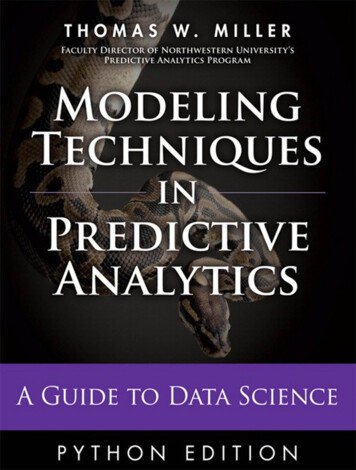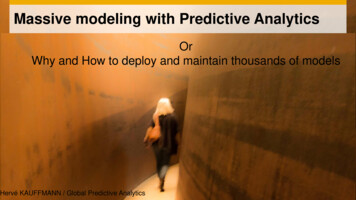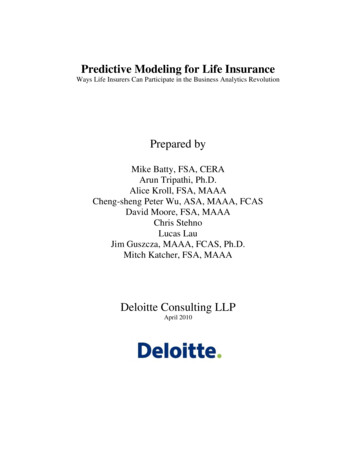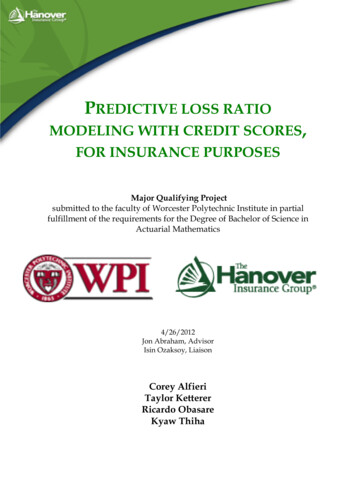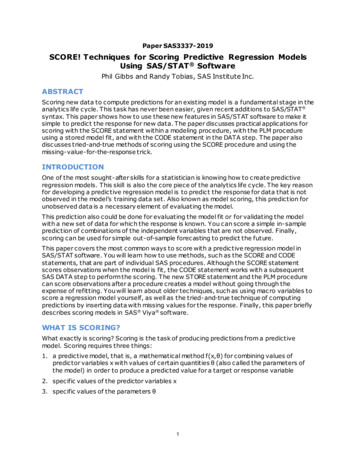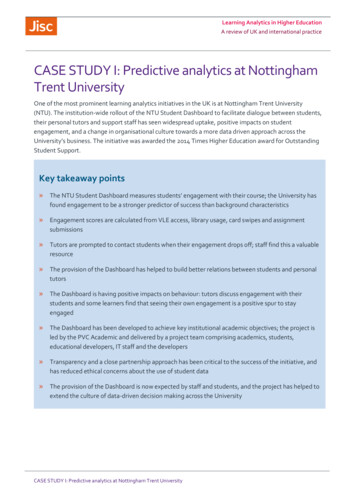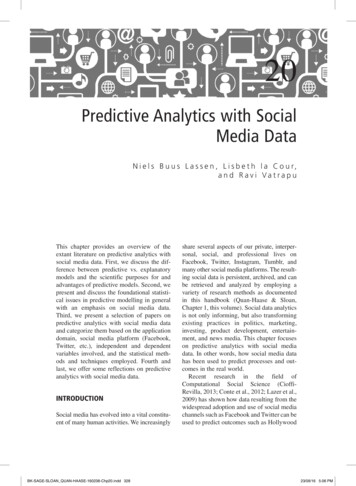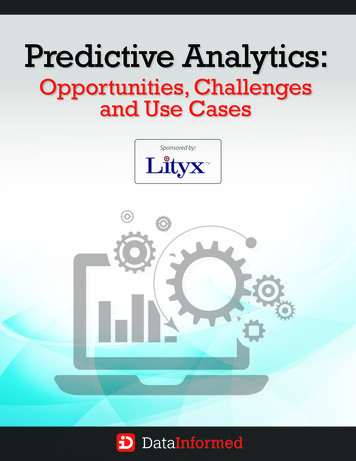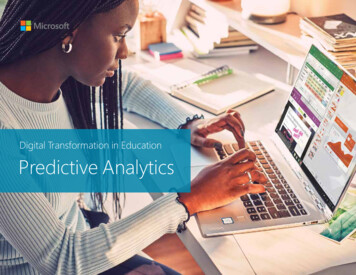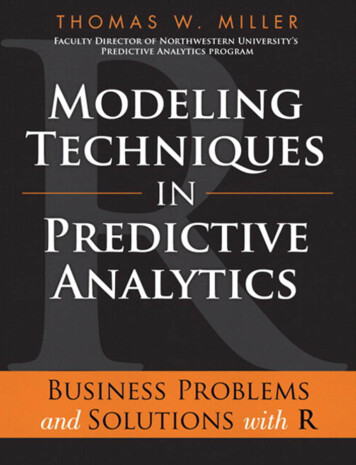
Transcription
Modeling Techniquesin Predictive AnalyticsBusiness Problems and Solutions with RT HOMAS W. M ILLER
Vice President, Publisher: Tim MooreAssociate Publisher and Director of Marketing: Amy NeidlingerExecutive Editor: Jeanne GlasserOperations Specialist: Jodi KemperCover Designer: Alan ClementsManaging Editor: Kristy HartProject Editor: Sara SchumacherSenior Compositor: Gloria SchurickManufacturing Buyer: Dan Uhrigc 2014 by Thomas W. MillerPublished by Pearson Education, Inc.Upper Saddle River, New Jersey 07458Pearson offers excellent discounts on this book when ordered in quantity for bulkpurchases or special sales. For more information, please contact U.S. Corporate andGovernment Sales, 1-800-382-3419, corpsales@pearsontechgroup.com. For salesoutside the U.S., please contact International Sales at international@pearsoned.com.Company and product names mentioned herein are the trademarks or registeredtrademarks of their respective owners.All rights reserved. No part of this book may be reproduced, in any form or by anymeans, without permission in writing from the publisher.Printed in the United States of AmericaFirst Printing August 2013ISBN-10: 0-13-341293-8ISBN-13: 978-0-13-341293-2Pearson Education LTD.Pearson Education Australia PTY, Limited.Pearson Education Singapore, Pte. Ltd.Pearson Education Asia, Ltd.Pearson Education Canada, Ltd.Pearson Educacin de Mexico, S.A. de C.V.Pearson Education—JapanPearson Education Malaysia, Pte. Ltd.Library of Congress Control Number: 2013946325
ytics and Data Science12Advertising and Promotion153Preference and Choice294Market Basket Analysis375Economic Data Analysis536Operations Management677Text Analytics838Sentiment Analysis1139Sports Analytics149iii
ivModeling Techniques in Predictive Analytics10 Brand and Price17311 Spatial Data Analysis20912 The Big Little Data Game231A There’s a Pack’ for That237A.1 Regression. . . . . . . . . . . . . . . . . . . . . . . . . . . . . . . 238A.2 Classification . . . . . . . . . . . . . . . . . . . . . . . . . . . . . . 240A.3 Recommender Systems . . . . . . . . . . . . . . . . . . . . . . . . . 242A.4 Product Positioning. . . . . . . . . . . . . . . . . . . . . . . . . . 244A.5 Segmentation and Target Marketing . . . . . . . . . . . . . . . . . . 246A.6 Finance and Risk Analytics. . . . . . . . . . . . . . . . . . . . . . 249A.7 Social Network Analysis . . . . . . . . . . . . . . . . . . . . . . . . 250B Measurement253C Code and Utilities267Bibliography297Index327
Preface“Toto, I’ve got a feeling we’re not in Kansas anymore.”—J UDY G ARLAND AS D OROTHY G ALE IN The Wizard of Oz (1939)Data and algorithms rule the day. Welcome to the new world of business, afast-paced, data-intensive world, an open-source world in which competitive advantage, however fleeting, is obtained through analytic prowess andthe sharing of ideas.Many books about predictive analytics talk about strategy and management. Some focus on methods and models. Others look at informationtechnology and code. This is that rare book that tries to do all three, appealing to modelers, programmers, and business managers alike.We recognize the importance of analytics in gaining competitive advantage.We help researchers and analysts by providing a ready resource and reference guide for modeling techniques. We show programmers how to buildupon a foundation of code that works to solve real business problems. Wetranslate the results of models into words and pictures that managementcan understand. We explain the meaning of data and models.Growth in the volume of data collected and stored, in the variety of dataavailable for analysis, and in the rate at which data arrive and require analysis, makes analytics more important with every passing day. Achievingcompetitive advantage means implementing new systems for informationmanagement and analytics. It means changing the way business is done.v
viModeling Techniques in Predictive AnalyticsCovering a variety of applications, this book is for people who want toknow about data, modeling techniques, and the benefits of analytics. Thisbook is for people who want to make things happen in their organizations.Predictive analytics is data science. The literature in the field is massive,drawing from many academic disciplines and application areas. The relevant code (even if we restrict ourselves to R) is growing quickly. Indeed,it would be a challenge to provide a comprehensive guide to predictiveanalytics. What we have done is offer a collection of vignettes with eachchapter focused on a particular application area and business problem.Our objective is to provide an overview of predictive analytics and datascience that is accessible to many readers. There is scant mathematics in thebook—statisticians and modelers may look to the references for details andderivations of methods. We describe methods in plain English and use datavisualization to show solutions to business problems.Given the subject of the book, some might wonder if I belong to either theclassical or Bayesian camp. At the School of Statistics at the University ofMinnesota, I developed a respect for both sides of the classical/Bayesiandivide. I regard highly the perspective of empirical Bayesians and thoseworking in statistical learning, an area that combines machine learning andtraditional statistics. I am a pragmatist when it comes to modeling andinference. I do what works and express my uncertainty in statements thatothers can understand.What made this book possible is the work of thousands of experts acrossthe world, people who contribute time and ideas to the R community. Thegrowth of R and the ease of growing it further ensures that the R environment for modeling techniques in predictive analytics will be aroundfor many years to come. Genie out of the lamp, wizard from behind thecurtain—rocket science is not what it used to be. Secrets are being revealed.This book is part of the process.Most of the data in the book were obtained from public domain data sources.Bobblehead promotional data were contributed by Erica Costello. Computer choice study data were made possible through work supported bySharon Chamberlain. The call center data of “Anonymous Bank” wereprovided by Avi Mandelbaum and Ilan Guedj. Movie information wasobtained courtesy of The Internet Movie Database, used with permission.
PrefaceIMDb movie reviews data were organized by Andrew L. Mass and his colleagues at Stanford University. Some examples were inspired by workingwith NCR Comten, Hewlett-Packard Company, Union Cab Cooperative ofMadison, Site Analytics Co. of New York, and Sunseed Research LLC ofMadison, Wisconsin.As with vignettes under the Comprehensive R Archive Network, programexamples in the book show what can be done with R. We work in a worldof open source, sharing with one another. The truth about what we do isin programs for everyone to see and for some to debug. The code in thisbook contains step-by-step comments to promote student learning. Eachprogram example ends with suggestions to build on the analysis that hasbeen presented.Many have influenced my intellectual development over the years. Therewere those good thinkers and good people, teachers and mentors for whomI will be forever grateful. Sadly, no longer with us are Gerald Hahn Hinklein philosophy and Allan Lake Rice in languages at Ursinus College, andHerbert Feigl in philosophy at the University of Minnesota. I am also mostthankful to David J. Weiss in psychometrics at the University of Minnesotaand Kelly Eakin in economics, formerly at the University of Oregon. Goodteachers—yes, great teachers—are valued for a lifetime.Thanks to Michael L. Rothschild, Neal M. Ford, Peter R. Dickson, and JanetChristopher who provided invaluable support during our years togetherat the University of Wisconsin–Madison and the A. C. Nielsen Center forMarketing Research.Those who know me well are not surprised by my move to the Los Angeles area. Two Major League Baseball teams, movies, and good weather is ahard combination to beat. I am most fortunate to be involved with graduate distance education at Northwestern University’s School of ContinuingStudies. Distance learning faculty and students at this school can live andwork anywhere they like.Thanks to Glen Fogerty who offered me the opportunity to teach and takea leadership role in the Predictive Analytics program at Northwestern University. Thanks to colleagues and staff who administer this exceptionalgraduate program. And thanks to the many students and fellow facultyfrom whom I have learned.vii
viiiModeling Techniques in Predictive AnalyticsAmy Hendrickson of TEXnology Inc. applied her craft, making words, tables, and figures look beautiful in print—another victory for open source.Thanks to Donald Knuth and the TEX/LATEX community for their contributions to this wonderful system for typesetting and publication.Thanks to readers and reviewers who provided much needed assistance, including Suzanne Callender, Philip M. Goldfeder, Melvin Ott, and Thomas P.Ryan. Jennifer Swartz provided proofreading assistance. Candice Bradleyserved dual roles as a reviewer and copyeditor. I am most grateful for theirfeedback and encouragement. Thanks to my editor, Jeanne Glasser Levine,and publisher, Pearson/FT Press, for making this book possible. Any writing issues, errors, or items of unfinished business, of course, are my responsibility alone.My good friend Brittney and her daughter Janiya keep me company whentime permits. And my son Daniel is there for me in good times and bad, afriend for life. My greatest debt is to them because they believe in me.Thomas W. MillerGlendale, CaliforniaJuly 2013
.44.54.65.15.25.35.45.55.66.16.26.3Data and models for research . . . . . . . . . . . . . . . . . . . . . . . . . .Training-and-Test Regimen for Model Evaluation . . . . . . . . . . . . .Training-and-Test Using Multi-fold Cross-validation . . . . . . . . . . .Training-and-Test with Bootstrap Resampling . . . . . . . . . . . . . . .Importance of Data Visualization: The Anscombe Quartet . . . . . . . .Dodgers Attendance by Day of Week . . . . . . . . . . . . . . . . . . . . .Dodgers Attendance by Month . . . . . . . . . . . . . . . . . . . . . . . . .Dodgers Weather, Fireworks, and Attendance . . . . . . . . . . . . . . .Dodgers Attendance by Visiting Team . . . . . . . . . . . . . . . . . . . .Regression Model Performance: Bobbleheads and Attendance . . . . .Spine Chart of Preferences for Mobile Communication Services . . . .Market Basket for One Shopping Trip . . . . . . . . . . . . . . . . . . . . .Market Basket Prevalence of Initial Grocery Items . . . . . . . . . . . . .Market Basket Prevalence of Grocery Items by Category . . . . . . . . .Market Basket Association Rules: Scatter Plot . . . . . . . . . . . . . . . .Market Basket Association Rules: Matrix Bubble Chart . . . . . . . . . .Association Rules for a Local Farmer: A Network Diagram . . . . . . .Multiple Time Series of Economic Data . . . . . . . . . . . . . . . . . . . .Horizon Plot of Indexed Economic Time Series . . . . . . . . . . . . . . .Forecast of National Civilian Employment Rate (percentage) . . . . . .Forecast of Manufacturers’ New Orders: Durable Goods (billions ofdollars) . . . . . . . . . . . . . . . . . . . . . . . . . . . . . . . . . . . . . .Forecast of University of Michigan Index of Consumer Sentiment (1Q1966 100) . . . . . . . . . . . . . . . . . . . . . . . . . . . . . . . . . . .Forecast of New Homes Sold (millions) . . . . . . . . . . . . . . . . . . .Call Center Operations for Monday . . . . . . . . . . . . . . . . . . . . . .Call Center Operations for Tuesday . . . . . . . . . . . . . . . . . . . . . .Call Center Operations for Wednesday . . . . . . . . . . . . . . . . . . . 0
xModeling Techniques in Predictive 10.110.210.310.410.510.6Call Center Operations for Thursday . . . . . . . . . . . . . . . . . . . .Call Center Operations for Friday . . . . . . . . . . . . . . . . . . . . . .Call Center Operations for Sunday . . . . . . . . . . . . . . . . . . . . .Call Center Arrival and Service Rates on Wednesdays . . . . . . . . .Call Center Needs and Optimal Workforce Schedule . . . . . . . . . .Movie Taglines from The Internet Movie Database (IMDb) . . . . . . .Movies by Year of Release . . . . . . . . . . . . . . . . . . . . . . . . . . .A Bag of 200 Words from Forty Years of Movie Taglines . . . . . . . .Picture of Text in Time: Forty Years of Movie Taglines . . . . . . . . .Text Measures and Documents on a Single Graph . . . . . . . . . . . .Horizon Plot of Text Measures across Forty Years of Movie Taglines .From Text Processing to Text Analytics . . . . . . . . . . . . . . . . . . .Linguistic Foundations of Text Analytics . . . . . . . . . . . . . . . . . .Creating a Terms-by-Documents Matrix . . . . . . . . . . . . . . . . . .An R Programmer’s Word Cloud . . . . . . . . . . . . . . . . . . . . . .A Few Movie Reviews According to Tom . . . . . . . . . . . . . . . . .A Few More Movie Reviews According to Tom . . . . . . . . . . . . . .Fifty Words of Sentiment . . . . . . . . . . . . . . . . . . . . . . . . . . .List-Based Text Measures for Four Movie Reviews . . . . . . . . . . . .Scatter Plot of Text Measures of Positive and Negative Sentiment . .Word Importance in Classifying Movie Reviews as Thumbs-Up orThumbs-Down . . . . . . . . . . . . . . . . . . . . . . . . . . . . . . . .A Simple Tree Classifier for Thumbs-Up or Thumbs-Down . . . . . .Predictive Modeling Framework for Picking a Winning Team . . . . .Game-day Simulation (offense only) . . . . . . . . . . . . . . . . . . . .Mets’ Away and Yankees’ Home Data (offense and defense) . . . . . .Balanced Game-day Simulation (offense and defense) . . . . . . . . .Actual and Theoretical Runs-scored Distributions . . . . . . . . . . . .Poisson Model for Mets vs. Yankees at Yankee Stadium . . . . . . . . .Negative Binomial Model for Mets vs. Yankees at Yankee Stadium . .Probability of Home Team Winning (Negative Binomial Model) . . .Computer Choice Study: One Choice Set . . . . . . . . . . . . . . . . .Computer Choice Study: A Mosaic of Top Brands and Most ValuedAttributes . . . . . . . . . . . . . . . . . . . . . . . . . . . . . . . . . . .Framework for Describing Consumer Preference and Choice . . . . .Ternary Plot of Consumer Preference and Choice . . . . . . . . . . . .Comparing Consumers with Differing Brand Preferences . . . . . . .Potential for Brand Switching: Parallel Coordinates for IndividualConsumers . . . . . . . . . . . . . . . . . . . . . . . . . . . . . . . . . 4.179125150156157158160162163165176181181182. 184
.4B.5B.6B.7B.8B.9B.10Potential for Brand Switching: Parallel Coordinates for ConsumerGroups . . . . . . . . . . . . . . . . . . . . . . . . . . . . . . . . . . . . . .Market Simulation: A Mosaic of Preference Shares . . . . . . . . . . . .California Housing Data: Correlation Heat Map for the Training DataCalifornia Housing Data: Scatter Plot Matrix of Selected Variables . . .Tree-Structured Regression for Predicting California Housing Values .Random Forests Regression for Predicting California Housing Values .From Data to Explanation . . . . . . . . . . . . . . . . . . . . . . . . . . . .Evaluating Predictive Accuracy for a Binary Classifier . . . . . . . . . .Hypothetical Multitrait-Multimethod Matrix . . . . . . . . . . . . . . . .Conjoint Degree-of-Interest Rating . . . . . . . . . . . . . . . . . . . . . .Conjoint Sliding Scale for Profile Pairs . . . . . . . . . . . . . . . . . . . .Paired Comparisons . . . . . . . . . . . . . . . . . . . . . . . . . . . . . . .Multiple-Rank-Orders . . . . . . . . . . . . . . . . . . . . . . . . . . . . . .Best-worst Item Provides Partial Paired Comparisons . . . . . . . . . . .Paired Comparison Choice Task . . . . . . . . . . . . . . . . . . . . . . . .Choice Set with Three Product Profiles . . . . . . . . . . . . . . . . . . . .Menu-based Choice Task . . . . . . . . . . . . . . . . . . . . . . . . . . . .Elimination Pick List . . . . . . . . . . . . . . . . . . . . . . . . . . . . . . 64265
This page intentionally left blank
10.310.410.511.111.211.3Data for the Anscombe Quartet . . . . . . . . . . . . . . . . . . . . . . . .Bobbleheads and Dodger Dogs . . . . . . . . . . . . . . . . . . . . . . . . .Regression of Attendance on Month, Day of Week, and BobbleheadPromotion . . . . . . . . . . . . . . . . . . . . . . . . . . . . . . . . . . . .Preference Data for Mobile Communication Services . . . . . . . . . . .Association Rules for a Local Farmer . . . . . . . . . . . . . . . . . . . . .Call Center Shifts and Needs for Wednesdays . . . . . . . . . . . . . . .Call Center Problem and Solution . . . . . . . . . . . . . . . . . . . . . . .List-Based Sentiment Measures from Tom’s Reviews . . . . . . . . . . .Accuracy of Text Classification for Movie Reviews (Thumbs-Up orThumbs-Down) . . . . . . . . . . . . . . . . . . . . . . . . . . . . . . . .Random Forest Text Measurement Model Applied to Tom’s MovieReviews . . . . . . . . . . . . . . . . . . . . . . . . . . . . . . . . . . . . .New York Mets’ Early Season Games in 2007 . . . . . . . . . . . . . . . .New York Yankees’ Early Season Games in 2007 . . . . . . . . . . . . . .Computer Choice Study: Product Attributes . . . . . . . . . . . . . . . .Computer Choice Study: Data for One Individual . . . . . . . . . . . . .Contingency Table of Top-ranked Brands and Most Valued AttributesMarket Simulation: Choice Set Input . . . . . . . . . . . . . . . . . . . . .Market Simulation: Preference Shares in a Hypothetical Four-brandMarket . . . . . . . . . . . . . . . . . . . . . . . . . . . . . . . . . . . . . .California Housing Data: Original and Computed Variables . . . . . .Linear Regression Fit to Selected California Block Groups . . . . . . . .Comparison of Regressions on Spatially Referenced Data . . . . . . . 1215218
This page intentionally left blank
C.2C.3C.4C.5C.6R Program for the Anscombe Quartet . . . . . . . . . . . . . . . . . . . . .Shaking Our Bobbleheads Yes and No . . . . . . . . . . . . . . . . . . . .Measuring and Modeling Individual Preferences . . . . . . . . . . . . .Market Basket Analysis of Grocery Store Data . . . . . . . . . . . . . . .Working with Economic Data . . . . . . . . . . . . . . . . . . . . . . . . . .Call Center Scheduling Problem and Solution . . . . . . . . . . . . . . .Text Analytics of Movie Taglines . . . . . . . . . . . . . . . . . . . . . . . .Sentiment Analysis and Classification of Movie Ratings . . . . . . . . .Winning Probabilities by Simulation (Negative Binomial Model) . . . .Computer Choice Study: Training and Testing with Hierarchical BayesPreference, Choice, and Market Simulation . . . . . . . . . . . . . . . . .California Housing Values: Regression and Spatial Regression ModelsConjoint Analysis Spine Chart . . . . . . . . . . . . . . . . . . . . . . . . .Market Simulation Utilities . . . . . . . . . . . . . . . . . . . . . . . . . . .Split-plotting Utilities . . . . . . . . . . . . . . . . . . . . . . . . . . . . . .Wait-time Ribbon Plot . . . . . . . . . . . . . . . . . . . . . . . . . . . . . .Word Scoring Code for Sentiment Analysis . . . . . . . . . . . . . . . . .Utilities for Spatial Data Analysis . . . . . . . . . . . . . . . . . . . . . . 6
This page intentionally left blank
1Analytics and Data ScienceMr. Maguire: “I just want to say one word to you, just one word.”Ben: ”Yes, sir.”Mr. Maguire: “Are you listening?”Ben: ”Yes, I am.”Mr. Maguire: “Plastics.”—WALTER B ROOKE AS M R . M AGUIRE AND D USTIN H OFFMANAS B EN (B ENJAMIN B RADDOCK ) IN The Graduate (1967)While earning a degree in philosophy may not be the best career move(unless a student plans to teach philosophy, and few of these positions areavailable), I greatly value my years as a student of philosophy and the liberal arts. For my bachelor’s degree, I wrote an honors paper on BertrandRussell. In graduate school at the University of Minnesota, I took coursesfrom one of the truly great philosophers, Herbert Feigl. I read about scienceand the search for truth, otherwise known as epistemology. My favoritephilosophy was logical empiricism.Although my days of “thinking about thinking” (which is how Feigl defined philosophy) are far behind me, in those early years of academic training I was able to develop a keen sense for what is real and what is just talk.1
2Modeling Techniques in Predictive AnalyticsWhen we use the word model in predictive analytics, we are referring to arepresentation of the world, a rendering or description of reality, an attemptto relate one set of variables to another. Limited, imprecise, but useful, amodel helps us to make sense of the world.Predictive analytics brings together management, information technology,and modeling. It is for today’s data-intensive world. Predictive analyticsis data science, a multidisciplinary skill set essential for success in business, nonprofit organizations, and government. Whether forecasting salesor market share, finding a good retail site or investment opportunity, identifying consumer segments and target markets, or assessing the potential ofnew products or risks associated with existing products, modeling methodsin predictive analytics provide the key.Data scientists, those working in the field of predictive analytics, speak thelanguage of business—accounting, finance, marketing, and management.They know about information technology, including data structures, algorithms, and object-oriented programming. They understand statisticalmodeling, machine learning, and mathematical programming. Data scientists are methodological eclectics, drawing from many scientific disciplinesand translating the results of empirical research into words and picturesthat management can understand.Predictive analytics, like much of statistics, involves searching for meaningful relationships among variables and representing those relationshipsin models. There are response variables—things we are trying to predict.There are explanatory variables or predictors—things we observe, manipulate, or control that could relate to the response.Regression and classification are two common types predictive models. Regression involves predicting a response with meaningful magnitude, suchas quantity sold, stock price, or return on investment. Classification involves predicting a categorical response. Which brand will be purchased?Will the consumer buy the product or not? Will the account holder pay offor default on the loan? Is this bank transaction true or fraudulent?Predictive modeling involves searching for useful predictors. Predictionproblems are defined by their width or number of potential predictors andtheir depth or number of observations or cases in the data set. It is the number of potential predictors in business, marketing, and investment analysis
Chapter 1. Analytics and Data ScienceFigure 1.1. Data and models for researchTraditional ResearchModelData-Adaptive ResearchReal DataReal DataModel-DependentResearchModelGenerated DataModelReal Datathat causes the most difficulty. There can be thousands of potential predictors with weak relationships to the response. With the aid of computers,hundreds or thousands of models can be fit to subsets of the data and testedon other subsets of the data, providing an evaluation of each predictor.Predictive modeling involves finding good subsets of predictors or explanatory variables. Models that fit the data well are better than models that fitthe data poorly. Simple models are better than complex models. Workingwith a list of useful predictors, we can fit many models to the available data,then evaluate those models by their simplicity and by how well they fit thedata.Consider three general approaches to research and modeling as employedin predictive analytics: traditional, data-adaptive, and model-dependent.See figure 1.1. The traditional approach to research and modeling beginswith the specification of a theory or model. Classical or Bayesian methodsof statistical inference are employed. Traditional methods, such as linearregression and logistic regression, estimate parameters for linear predictors.Model building involves fitting models to data. After we have fit a model,we can check it using model diagnostics.When we employ a data-adaptive approach, we begin with data and searchthrough those data to find useful predictors. We give little thought to the-3
4Modeling Techniques in Predictive Analyticsories or hypotheses prior to running the analysis. This is the world of machine learning, sometimes called statistical learning or data mining. Dataadaptive methods adapt to the available data, representing nonlinear relationships and interactions among variables. The data determine the model.Data-adaptive methods are data-driven.Model-dependent research is the third approach. It begins with the specification of a model and uses that model to generate data, predictions, orrecommendations. Simulations and mathematical programming methods,primary tools of operations research, are examples of model-dependentresearch. When employing a model-dependent or simulation approach,models are improved by comparing generated data with real data. Weask whether simulated consumers, firms, and markets behave like real consumers, firms, and markets.It is often a combination of models and methods that works best. Consideran application from the field of financial research. The manager of a mutualfund is looking for additional stocks for a fund’s portfolio. A financial engineer employs a data-adaptive model (perhaps a neural network) to searchacross thousands of performance indictors and stocks, identifying a subsetof stocks for further analysis. Then, working with that subset of stocks,the financial engineer employs a theory-based approach (CAPM, the capital asset pricing model) to identify a smaller set of stocks to recommend tothe fund manager. As a final step, using model-dependent research (mathematical programming), the engineer identifies the minimum-risk capitalinvestment for each of the stocks in the portfolio.Data may be organized by observational unit, time, and space. The observational or cross-sectional unit could be an individual consumer or businessor any other basis for collecting and grouping data. Data are organized intime by seconds, minutes, hours, days, and so on. Space or location is oftendefined by longitude and latitude.Consider numbers of customers entering grocery stores (units of analysis)in Glendale, California on Monday (one point in time), ignoring the spatial location of the stores—these are cross-sectional data. Suppose we workwith one of those stores, looking at numbers of customers entering the storeeach day of the week for six months—these are time series data. Thenwe look at numbers of customers at all of the grocery stores in Glendale
Chapter 1. Analytics and Data Scienceacross six months—these are longitudinal or panel data. To complete ourstudy, we locate these stores by longitude and latitude, so we have spatialor spatio-temporal data. For any of these data structures we could considermeasures in addition to the number of customers entering stores. We lookat store sales, consumer or nearby resident demographics, traffic on Glendale streets, and so doing move to multiple time series and multivariatemethods. The organization of the data we collect affects the structure of themodels we employ.As we consider business problems in this book, we touch on many typesof models, including cross-sectional, time series, and spatial data models.Whatever the structure of the data and associated models, prediction is theunifying theme. We use the data we have to predict data we do not yethave, recognizing that prediction is a precarious enterprise. It is the processof extrapolating and forecasting.To make predictions, we may employ classical or Bayesian methods. Orwe may dispense with parametric formulations entirely and rely upon machine learning algorithms. We do what works.1 Our approach to predictiveanalytics is based upon a simple premise:The value of a model lies in the quality of its predictions.We learn from statistics that we should quantify our uncertainty. On the onehand, we have confidence intervals, point estimates with associated standard errors, and significance tests—that is the classical way. On the otherhand, we have probability intervals, prediction intervals, Bayes factors,subjective (perhaps diffuse) priors, and posterior probability distributions—the path of Bayesian statistics. Indices like the Akaike information criterion (AIC) or the Bayes information criterion (BIC) help us to to judge onemodel against another, providing a balance between goodness-of-fit andparsimony.Central to our approach is a training-and-test regimen. We partition sampledata into training and test sets. We build our model on the training set and1 Within the statistical literature, Seymour Geisser (1929–2004) introduced an approach best describedas Bayesian predictive inference (Geisser 1993). Bayesian statistics is named after Reverend Thomas Bayes(1706–1761), the creator of Bayes Theorem. In our emphasis upon the success of predictions, we are inagreement with Geisser. Our approach, however, is purely empiri
vi Modeling Techniques in Predictive Analytics Covering a variety of applications, this book is for people who want to know about data, modeling techniques, and the benefits of analytics. This book is for people who want to make things happen in their organizations. Predictive analytic
